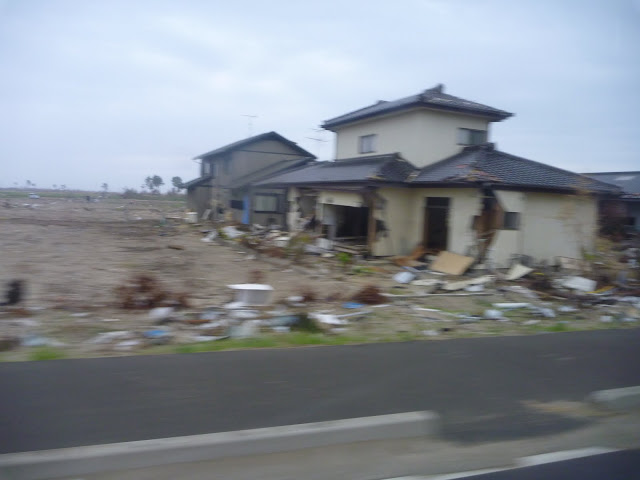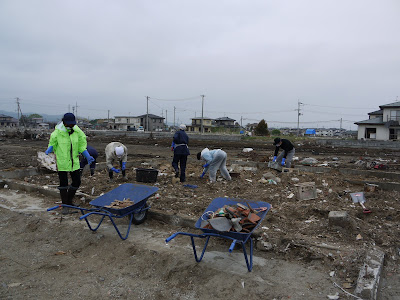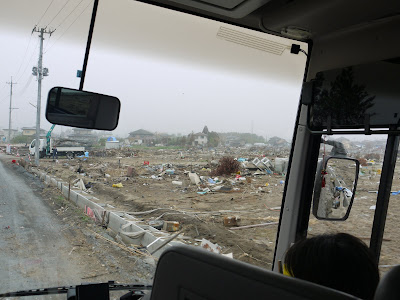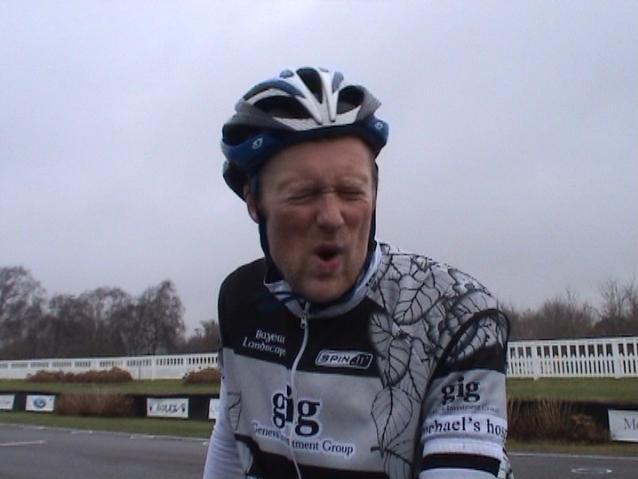I awoke in a dark, cramped hotel room in Hachioji and stumbled to turn off my alarm. I felt terrible, only 2 1/2 hours' sleep, still dehydrated from too much beer and not enough food despite some glasses of water before sleeping, still tired from way too late a train ride out to Hachioji -- on the 11:45PM train from Shinjuku, arriving around 12:30AM, then wandering in the dark through a "gauntlet" of questionable entertainment joints to find my business hotel. Guys in suits standing in the street wearing sun glasses at midnight, pairs of girls in the shadows.
Anyway, at 3:40AM I needed to scramble, try to consume and keep down some convenience store sandwiches, two small yogurts, plus a cold Seattle's Best Double Espresso I had bought on the way into the hotel a few hours earlier, dress, shave, pack my bags, assemble my bike in the hallway (not enough room in the room!) and hit the road. It took longer than it should have, and was after 4:10AM by the time I left the hotel, 10+ minutes behind schedule and not a moment to lose. Our start was 4:40AM, and I first needed to get to Takaosan-guchi, check-in, deliver my rucksack and drop-bag, find my teammates, and get ready to actually, well, race a bicycle.
About 15 minutes later, passing the Positivo Espresso recommended 7-11 on Rte 20 in front of Takao station, after riding much too hard for a warm up, I heard a woman's voice say "Litt-san!" It was the-nice-woman-whose-name-I-did-not-get from the staff at the
May 7 Saitama Brevet. She was riding with a man in "Pedal Far" bib shorts (her husband, perhaps?) up toward the start. She asked "do you remember me, from the Saitama Brevet?" "Yes of course," I said. "What time is your start." She responded "I did not ride I was on the staff." My Japanese must have been as garbled as my mind. "I said, "no, not the Brevet, your start today". She said "I'm not riding, I'm "o-en-dan" (support for a participant -- support, fan club or cheerleader, maybe). I just mumbled "excuse me, I'm late, I've got a 4:40AM start" and pushed ahead. So I still did not get her name, or learn any more about her (or the man riding with her, who looked like a strong rider). I guess if I keep up these endurance rides, I'll probably see them again.
I arrived at the start area at 4:33AM, just as Travis was trying to call my mobile phone and he, Gunnar, Steve and Yair were talking about a revised 4-man team race strategy. I checked in, dropped off my bags, tried (not very successfully) to catch my breath, and had the foresight to pull out my camera and ask someone to take our team photo.
 |
Yair, David, Gunnar, Steve and Travis -- P.E. 2011 TOITO team, in TCC jerseys (except for Yair "Sufferfest" Bauer) |
Unfortunately, I did not have the foresight to clean the fog off of the lens, or to hand the camera to someone with a steady hand -- so the photo gives a remarkably accurate idea of how I was perceiving the world at this time.
And then we were off! We started with 4 of the riders from Team Cuore -- a Japanese group of very enthusiastic riders based around a shop in Taito-ku, Tokyo -- and several others.
As feared, I lost the back of our group on the first climb, to Otarumi, and cleared the pass in just over 16 minutes -- 90-100 seconds slower than a week earlier despite my best efforts to stay with the team. Was it really a smart idea for me to ride (race) with these guys, whose average age is 12 years' younger?
But on the descent, I passed several of the Cuore riders and Yair (who really needs to add some weight if he wants to "drop like a rock" on the descents. He is looking slimmer than Alberto Contador and with just as spindly arms). I caught the rest of the team just as they were starting up at the traffic light in front of Sagami-ko station. I felt semi-human again.
On the 60-70 meter elevation climb up to Uenohara, I again lost the back, but on the next downhill, I timed (luck) the light at the bottom perfectly and, going 60 kph, passed my 4 teammates plus another 5-6 riders onto the next climb, then rode generally with (or within hailing distance of) the team to Otsuki. I lagged again on the climb to Sasago, but passed various groups of other riders and arrived only 5 minutes back of the team, with an average speed of 26.74 kph for the leg. Not that bad a start after all -- 75th fastest time on that leg out of 359 finishers (and also an unstated number of "DNFs" -- we saw some riders struggling and other resting who surely did not make it all the way by the cut off time).
Anyway, a 292 km ride is too long for a "blow by blow" account, ... and I've got some work and then want to catch a bit of the Giro, so let me give a few highlights.
First the results:
1. Andy Wood won for the Nth straight year, with a time of 8:44:43. He passed me near Chino and shouted out a greeting, recognizing my TCC jersey. I was about to say something back ... but he was gone. I think I did see TT bar extensions, but I did not get a chance to measure whether they exceeded the permitted limits under the TOITO rules.
2. Tom S. put in another very strong performance, with a time of 9:43:09 for 11th place overall, 5th in the 40-49 age group. Chapeau!
3. In 3rd place at 9:12:43 was Kondo-san, the fabled Brevet rider (see my 600 km May 7 Brevet report), riding for Nalshima.
4. Our team had some excellent results.
Travis finished 52nd in 10:57:45. Double Chapeau!
Gunnar outsprinted Steve to the line for 71st place, in 11:19:18. Steve took 72nd in 11:19:21. They rode very well together as a pair -- really ought to aim for Transalp at some point.
Yair, still recovering from an injury this winter and only 2 months back on the (beautiful new) bike, suffered through the middle/late segments but still managed to equal last year's P.E. group time, at 12:28:59, for 165th. With this ride under his belt, Yair is back.
5. The wind shifted throughout the day -- we had a headwind coming down into Kofu, tailwind between Shiojiri and Matsumoto, and then a cross wind, then a headwind from just before the lakes South of Hakuba until the finish. The last was at times a very stiff headwind, offsetting the speed of the descent. We all suffered in the heat during the 78 km stage between Shiojiri and Hakuba ... many of us taking an unscheduled convenience store break early in the long climb, and me deciding I was in danger of serious consequences if I pushed too hard, and so taking it easy for awhile.
When it came, the headwind was cool and, thus, a real relief. I kept repeating to myself, "the wind is keeping me cool, be thankful for the breeze, ... and tuck low enough so it runs over along your back, inside and down your jersey". Overheated, I was happy to sacrifice a bit of speed for the longer term relief from the cooling effect. As I emerged from the last of the tunnels on Route 148, into a noticeably cooler area, I welcomed the cloud cover, threatening skies and wind, the heat a distant memory.
6. I did not ride any of the "no bicycles allowed" overpasses in Kofu. I went with the Japanese riders along the side street, and waited, and waited, and waited, at the lights. At one of these, there were about 15 riders and a truck and few cars ahead of me. The light finally turned green, the truck, cars and maybe 3 riders went through before it turned red again, 10 riders ahead and so no chance to sprint the light on yellow-changing-to-red ... another 4-5 minutes wait, it seemed, during which all the lights I could see at the intersection were red, cars just sitting and nothing moving in any direction. Aaaaargh! Also, this time, I did much less running of red signals than in 2008 with Juliane, DJ and MOB. Hard to argue that I don't know better this time. ... but I did get alone for a good part of the Shiojiri-Matsumoto stretch, and was able to time the lights very well, move to the front of waiting traffic, pass through when no cars were approaching and the light had changed to a "right turn only" arrow -- the usual tricks, without doing anything dangerous or attention-getting. How much of the difference among the top riders is really just a question of how many rules they break?
Later, I was able to persuade a Japanese rider to join me in going through some "T" intersections (along the top side of the "T"), and to make a left turn on red (remember, this is Japan - riding on the left, slinking around the corner, and continuing along the left), against some useless red lights. He eventually went ahead of me and I could see him, at the next "T" intersection, go up onto the sidewalk, around the intersection, and back into the street again, avoiding the red light -- all perfectly safe. He learned quickly.
I had very bad luck with road construction on the Hakuba-Itoigawa stretch, with several lengthy waits for one-way traffic the other way.
7. Travis, Gunnar and Steve did try at least one Kofu overpass, but one of the other riders yelled at them from the side street, causing Steve to look over to see who was yelling, and why, ... and he ran straight onto the dividers/chevrons between the overpass and side road, flatting both front and rear tires, with some rim damage and a big jolt and big scare ... but not enough of a scare to keep him from continuing on. I was a few minutes back and missed the excitement, and just passed a smiling Steve who was walking his bike back ... I thought looking for something he had dropped. Anyway, Travis and Gunnar went back to help, I went on slowly, and we regrouped at Nirasaki ... only for them to go on ahead of me up the hill.
8. The route was noticeably better than I had remembered. No big trucks coming down the tunnels this Saturday afternoon ... though I did see a few going the other way. And there was an improved road surface and wider shoulder, I think for a good part of the stretch around Matsumoto. And reverted from a 2008 detour to the "usual" route again North of Matsumoto. Also, the checkpoints were far better stocked with bananas, rice balls and drinks -- water, mugi-cha and pokari sweat -- when riding with a 4:40 AM start than with our 2008 6:25 AM start.
And we saw many more team cars and supporters on the side of the road, cheering us on up the climb after Nirasaki and again later on. There were two young, attractive ladies dressed up in "maid" costumes, standing by their car on several of the climbs cheering us on, jumping up and down.
I blew them a kiss as I passed the second time, but meanwhile I could only think ... of this past week's news of Arnold the Governator and his child by a former housekeeper leading to his separation from Maria Shriver, that news from California following just a few days after Dominique Strauss-Kahn's arrest for his alleged brutal attack on a chambermaid at the Hotel Sofitel in Manhattan ... what is it with these guys and the maid costumes?
9. With my long explanation of the Kofu red lights, the road construction, miserable afternoon heat and the headwinds, I've just about run out of excuses.
Anyway, my time was 12:06:42, which placed me 137 out of 359 finishers. This was 20 minutes better than in 2008, though I was really hoping to get somewhere comfortably under 12 hours. Still, not bad, all things considered.
And when I reached the hotel driveway entrance, I was surprised -- done so soon? I thought I still had a few more kilometers to go. Why did I leave so much in the tank at the end? Sunday morning, but for the rain and the press of work, I would definitely have headed up the coast on my bike. The only aches or pains during the ride were some numbness in my feet -- I need to check my right cleat alignment. So even if my time was not so much better than 2008, the Brevets have definitely helped my endurance. Now, over the next 3 weeks, I just need to try to do more climbing practice, then I'll be ready for Transalp.
By the time I finished, Travis was gone, headed to the station then back to Tokyo. Tom was waiting and offered his congratulations before heading into Itoigawa with his Vlaams teammates. We unwound, soaked in the onsen, enjoyed our bento boxes out front of the hotel, with some extras (tonjiru udon, cucumbers w/ salt, beer), added 2 pizzas later -- ordered and delivered to our hotel room -- chatted with Saito-san, a neighbor from the Cuore team in the room next door, who offered me a taste of a nice Burgundy Pinot Noir. We all slept early and very soundly.
After breakfast, we braved the pounding rain on Sunday morning to the station and hopped the train back to Tokyo.
Another successful event. Will we go back next year? Too soon to say.
 |
Our team at the start -- second try at a photo, after cleaning the camera lens.
Look at those faces-- is that a unified expression of determination to ride to victory, or what? |
 |
Gunnar models the hotel yukata -- and seems to be having some trouble straightening his back and unclasping his hands after the new experience of riding 300 km in a day. One of the older, male riders complimented Gunnar on his yukata ("ni-aimasu") and no one reproached him for wearing the hotel slippers outside. ... the guy who yelled at Steve in Kofu must have been DNF, or maybe still on the road at this point. |
 |
Tom S. prepares to ride into Itoigawa to his lodgings. |
 |
The Sea of Japan and wet roads, from our train. |
Travis' report:
http://www.tokyocycle.com/bbs/blog.php?b=91Tom's report:
http://vlaamsewielrenner.blogspot.com/2011/05/40th-classic-300km-endurance-race.htmlAndy's report:
http://www.jyonnobitime.com/time/2011/05/tokyo-itoigawa-2011-race-repor.html









































 ´touched" the Lunebürger Heide as you can see on the map. We ventured inside, made a loop and turned back where we came from, just like an unsuccessful expedition in the 19th century venturing to find the origins of the river Nile.
´touched" the Lunebürger Heide as you can see on the map. We ventured inside, made a loop and turned back where we came from, just like an unsuccessful expedition in the 19th century venturing to find the origins of the river Nile. 













